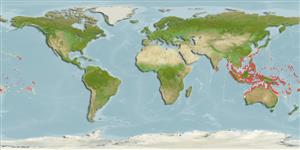Common names from other countries
Classification / Names / Names
Namen | Synonyme | Catalog of Fishes (gen., sp.) | ITIS | CoL | WoRMS
Environment: milieu / climate zone / depth range / distribution range
Ökologie
Riff-verbunden; tiefenbereich 3 - 20 m (Ref. 8294). Tropical; 36°N - 31°S, 32°E - 137°W (Ref. 847)
Indo-Pacific.
Length at first maturity / Size / Gewicht / Alter
Maturity: Lm ? range ? - ? cm Max length : 30.0 cm COLD Männchen/unbestimmt; (Ref. 269)
The coral is circular in outline, up to 30 cm in diameter. The upper surface is fairly rough due to moderate to deeply incised septal dentations on most septocostae, and the lower surface is rough due to costal spines (Ref. 269). The coral is circular in outline, up to 30 cm in diameter.
Maximum depth from Ref. 98471. Found at intermediate depths on reef slopes (Ref. 269). Also on back reefs, reef flats, and lagoons. Solitary, free-living (Ref. 98471).
Life cycle and mating behavior
Geschlechtsreife | Fortpflanzung | Ablaichen | Eier | Fecundity | Larven
Mature gametes are shed into the coelenteron and spawned through the mouth. Life cycle: The zygote develops into a planktonic planula larva. Metamorphosis begins with early morphogenesis of tentacles, septa and pharynx before larval settlement on the aboral end (Ref. 833).
Hodgson, G. 1998. (Ref. 269)
IUCN Rote Liste Status (Ref. 130435)
CITES Status (Ref. 108899)
Not Evaluated
Nutzung durch Menschen
| FishSource |
Tools
Internet Quellen
Estimates based on models
Preferred temperature
(Ref.
115969): 25.4 - 29.3, mean 28.6 (based on 2495 cells).
Verwundbarkeit
Low vulnerability (20 of 100).
Preiskategorie
Unknown.
